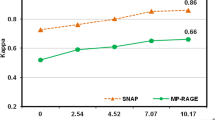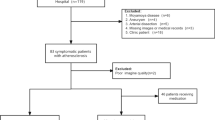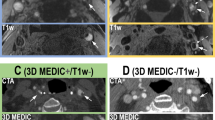Abstract
Objectives
To investigate the usefulness of Simultaneous Non-contrast Angiography and intraPlaque haemorrhage (SNAP) imaging in characterising carotid intraplaque haemorrhage (IPH) compared with magnetisation-prepared rapid acquisition gradient-echo (MP-RAGE) sequence.
Methods
Fifty-four symptomatic patients (mean age: 63.1 ± 5.7 years, 38 males) with carotid atherosclerosis were recruited and underwent carotid MR imaging. The presence and area of IPH on SNAP and MP-RAGE images were determined. The agreement in identifying IPH and its area between SNAP and MP-RAGE was analysed.
Results
Of 1368 slices with acceptable image quality in 54 patients, 13% and 22.6% were found to have IPH on MP-RAGE and SNAP images, respectively. There was moderate agreement between MP-RAGE and SNAP sequences in identifying IPH (κ = 0.511, p = 0.029). The area of IPH on SNAP images was significantly larger than that on MP-RAGE images (17.9 ± 18.2 mm2 vs. 9.2 ± 10.5 mm2, p < 0.001). For IPHs detected by SNAP imaging, the area of IPHs also detected by the MP-RAGE sequence was significantly larger than that of IPHs not detected by the MP-RAGE sequence (17.9 ± 19.2 mm2 vs. 6.4 ± 6.2 mm2, p < 0.001).
Conclusion
Compared with the MP-RAGE sequence, SNAP imaging detects more IPHs, particularly for smaller IPHs, suggesting that SNAP imaging might be a more sensitive tool for identification of carotid haemorrhagic plaques.
Key Points
• Moderate agreement was found between SNAP and MP-RAGE in identification of IPH
• SNAP imaging might be a more sensitive tool to detect carotid IPHs
• Compared with the MP-RAGE sequence, SNAP imaging can detect carotid IPHs with smaller size
• SNAP imaging can help clinicians to optimise the treatment strategy



Similar content being viewed by others
Abbreviations
- IPH:
-
intraplaque haemorrhage
- MP-RAGE:
-
Magnetisation-prepared rapid acquisition gradient-echo
- SNAP:
-
Simultaneous non-contrast angiography and intraplaque haemorrhage
- MR:
-
Magnetic resonance
- MRA:
-
Magnetic resonance angiography
References
Takaya N, Yuan C, Chu B et al (2005) Presence of intraplaque hemorrhage stimulates progression of carotid atherosclerotic plaques: a high-resolution magnetic resonance imaging study. Circulation 111:2768–2775
Underhill HR, Yuan C, Yarnykh VL et al (2009) Arterial remodeling in the subclinical carotid artery disease. JACC Cardiovasc Imaging 2:1381–1389
WH X, Li ML, Gao S et al (2012) Middle cerebral artery intraplaque hemorrhage: prevalence and clinical relevance. Ann Neurol 71:195–198
Singh N, Moody AR, Gladstone DJ et al (2009) Moderate carotid artery stenosis: MR imaging-depicted intraplaque hemorrhage predicts risk of cerebrovascular ischemic events in asymptomatic men. Radiology 252:502–508
Altaf N, Daniels L, Morgan PS et al (2008) Detection of intraplaque hemorrhage by magnetic resonance imaging in symptomatic patients with mild to moderate carotid stenosis predicts recurrent neurological events. J Vasc Surg 47:337–342
Takaya N, Yuan C, Chu B et al (2006) Association between carotid plaque characteristics and subsequent ischemic cerebrovascular events: a prospective assessment with MRI--initial results. Stroke 37:818–823
Noguchi T, Yamada N, Higashi M et al (2011) High-intensity signals in carotid plaques on T1-weighted magnetic resonance imaging predict coronary events in patients with coronary artery disease. JACC Cardiovasc Imaging 58:416–422
Yamada K, Yoshimura S, Kawasaki M et al (2011) Embolic complications after carotid artery stenting or carotid endarterectomy are associated with tissue characteristics of carotid plaques evaluated by magnetic resonance imaging. Atherosclerosis 215:399–404
Ota H, Yarnykh VL, Ferguson MS et al (2010) Carotid intraplaque hemorrhage imaging at 3.0-T MR imaging: comparison of the diagnostic performance of three T1-weighted sequences. Radiology 254:551–563
Yao B, Yang L, Wang G et al (2016) Diffusion measurement of intraplaque hemorrhage and intramural hematoma using diffusion weighted MRI at 3T in cervical artery. Eur Radiol 26:3737–3743
Wang J, Börnert P, Zhao H et al (2013) Simultaneous non-contrast angiography and intraplaque hemorrhage (SNAP) imaging for carotid atherosclerotic disease evaluation. Magn Reson Med 69:337–345
Kerwin W, Xu D, Liu F et al (2007) Magnetic resonance imaging of carotid atherosclerosis: plaque analysis. Top Magn Reson imaging 18:371–378
Underhill HR, Yuan C, Terry JG et al (2008) Differences in carotid arterial morphology and composition between individuals with and without obstructive coronary artery disease: a cardiovascular magnetic resonance study. J Cardiovasc Magn Reson 10:1–11
Wang J, Ferguson MS, Balu N et al (2010) Improved carotid intraplaque hemorrhage imaging using a slab-selective phase-sensitive inversion-recovery (SPI) sequence. Magn Reson Med 64:1332–1340
Liu J, Balu N, Hippe DS et al (2016) Semi-automatic carotid intraplaque hemorrhage detection and quantification on magnetization-prepared rapid acquisition gradient-echo (MP-RAGE) with optimized threshold selection. J Cardiovasc Magn Reson 18:41
Li Q, Wang J, Chen H et al (2015) Characterization of craniocervical artery dissection by simultaneous MR noncontrast angiography and intraplaque hemorrhage imaging at 3T. AJNR Am J Neuroradiol 36:1769–1775
Wang J, Guan M, Yamada K et al (2016) In vivo validation of simultaneous non- contrast angiography and intraPlaque hemorrhage (SNAP) magnetic resonance angiography: An intracranial artery study. Plos One 11:e0149130
Funding
This study is funded by the grants from the National Natural Science Foundation of China (81771825, 81361120402) and Beijing Municipal Science and Technology Project (D131100002313002).
Author information
Authors and Affiliations
Corresponding author
Ethics declarations
Guarantor
The scientific guarantor of this publication is Xihai Zhao MD, PhD.
Conflict of interest
The authors of this manuscript declare no relationships with any companies, whose products or services may be related to the subject matter of the article.
Statistics and biometry
No complex statistical methods were necessary for this paper.
Informed consent
Written informed consent was obtained from all subjects (patients) in this study.
Methodology
• Retrospective
• Observational
• Performed at one institution
Rights and permissions
About this article
Cite this article
Li, D., Zhao, H., Chen, X. et al. Identification of intraplaque haemorrhage in carotid artery by simultaneous non-contrast angiography and intraPlaque haemorrhage (SNAP) imaging: a magnetic resonance vessel wall imaging study. Eur Radiol 28, 1681–1686 (2018). https://doi.org/10.1007/s00330-017-5096-1
Received:
Revised:
Accepted:
Published:
Issue Date:
DOI: https://doi.org/10.1007/s00330-017-5096-1




